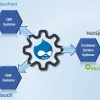Executive Summary
Many companies today need to manage several websites at once—for different brands, regions, or languages. Doing this with separate systems can be slow, expensive, and hard to develop and support. Drupal Multisite helps solve this by using one shared codebase to run many websites. Each site can look and work differently, but updates, security, and features stay consistent.
This article explains how Drupal Multisite works, why it’s useful for growing businesses, and how it helps technical teams build faster, smarter, and more flexible web platforms.
Why Companies Choose Drupal Multisite
When a company decides to create a new brand or open a new branch, the first idea is often to copy the codebase and set up a new website. But as the number of sites grows, this approach becomes difficult. The company starts facing problems when updating modules, adding new features, or expanding existing ones.
Managing each site separately takes more time and effort. The development team has to repeat the same work for every website. Drupal Multisite solves this by using one shared system for many websites. It helps companies save time, reduce costs, and keep everything secure and consistent. Each site can still have its own design and content, but the core tools and updates stay the same.
Core Concepts of Drupal Multisite Architecture
Drupal Multisite lets you run many websites from one shared system. Each site has its own folder inside the sites/ directory, like sites/site1.example.com or sites/blog.example.com. These folders store settings and files for each site.
To help Drupal match domains or subdomains to the correct folder, you can use a file called sites.php. This file maps incoming domain names to folder names. For example, if someone visits shop.example.com, Drupal checks sites.php and loads the folder sites/shop.example.com. This is useful when you manage many subdomains or regional sites.
You can also use wildcards or custom logic in sites.php to handle dynamic subdomains like region1.example.com, region2.example.com, and so on. This gives you flexibility to scale without creating dozens of manual folders.
Additionally, you can use domain formats like domain.com, subdomain.domain.com, or domain.com/prefix. In the last case, you just need to convert the host to domain.com.prefix on the webserver side.
With this setup, each site can have its own content and design, while sharing the same codebase and updates. It’s a clean and powerful way to manage multiple websites with less effort.
Real-World Scenarios and Use Cases
Many companies use Drupal Multisite to manage several websites at once. For example, a university can create separate sites for each department, while keeping shared tools like login and search. A retail brand can run different regional sites—like us.example.com, de.example.com, and jp.example.com—with local content but shared design and features.
Franchise businesses also benefit from this setup. Each location can have its own site with local news and offers, while the main company controls branding and updates. This helps teams work faster, reduce costs, and keep everything consistent across many websites.
Conclusion: Infinite Possibilities, One Platform
Drupal Multisite gives teams a smart way to manage many websites from one system. It helps save time, reduce costs, and keep everything organized. Each site can be unique, but updates and features stay consistent across the platform.
For growing businesses and technical teams, this means more control, better performance, and faster results. With one codebase and flexible tools, Drupal Multisite opens the door to endless possibilities.





